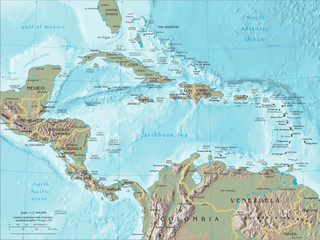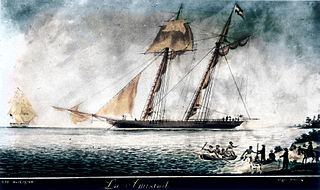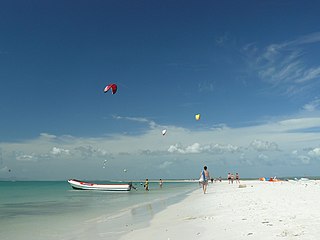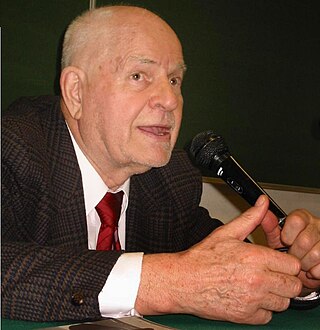
Cover art by Zbigniew Rychlicki
Robinson Crusoe Island (Polish : Wyspa Robinsona) is a historical adventure novel for young people by Polish author Arkady Fiedler. [1] It was first published in 1954.

Robinson Crusoe Island (Polish : Wyspa Robinsona) is a historical adventure novel for young people by Polish author Arkady Fiedler. [1] It was first published in 1954.
The story takes place on Coche Island, 1725-1726. The protagonist Jan (John) Bober, a half-Polish half-English Virginia pioneer, flees from government pursuit in a pirate ship. However, it runs into heavy water and wrecks near the island. Jan and his two Arawak companions Arnak and Wagura (former slaves from the ship), the only survivors of the shipwreck, live on the island for over a year. Later they accept onto the island a group of escaped slaves from Margarita Island and, combining forces, defeat Spanish slaver pursuers and seize their ship. Fearing Spanish revenge, Jan and his followers leave the island on the captured ship. Their adventures continue in the two next Arkady Fiedler's novels Orinoco (Orinoko, 1957) and The White Jaguar (Biały Jaguar, 1980).

Robinson Crusoe is an English adventure novel by Daniel Defoe, first published on 25 April 1719. Written with a combination of epistolary, confessional, and didactic forms, the book follows the title character after he is cast away and spends 28 years on a remote tropical desert island near the coasts of Venezuela and Trinidad, encountering cannibals, captives, and mutineers before being rescued. The story has been thought to be based on the life of Alexander Selkirk, a Scottish castaway who lived for four years on a Pacific island called "Más a Tierra" which was renamed Robinson Crusoe Island in 1966. Pedro Serrano is another real-life castaway whose story might have inspired the novel.

The era of piracy in the Caribbean began in the 1500s and phased out in the 1830s after the navies of the nations of Western Europe and North America with colonies in the Caribbean began hunting and prosecuting pirates. The period during which pirates were most successful was from the 1650s to the 1730s. Piracy flourished in the Caribbean because of the existence of pirate seaports such as Port Royal in Jamaica, Tortuga in Haiti, and Nassau in the Bahamas. Piracy in the Caribbean was part of a larger historical phenomenon of piracy, as it existed close to major trade and exploration routes in almost all the five oceans.

Marooning is the intentional act of abandoning someone in an uninhabited area, such as a desert island, or more generally to be marooned is to be in a place from which one cannot escape. The word is attested in 1699, and is derived from the term maroon, a word for a fugitive slave, which could be a corruption of Spanish cimarrón, meaning a household animal who has "run wild". Cimarrón in turn may be derived from the Taino word símaran (“wild”), from símara (“arrow”).
A galley slave was a slave rowing in a galley, either a convicted criminal sentenced to work at the oar, or a kind of human chattel, sometimes a prisoner of war, assigned to the duty of rowing.

Arkady Fiedler was a Polish writer, journalist and adventurer.

Two Years' Vacation is an adventure novel by Jules Verne, published in 1888. The story tells of the fortunes of a group of schoolboys stranded on a deserted island in the South Pacific, and of their struggles to overcome adversity. In his preface to the book, Verne explains that his goals were to create a Robinson Crusoe-like environment for children, and to show the world what the intelligence and bravery of a child were capable of when put to the test.

La Amistad was a 19th-century two-masted schooner owned by a Spaniard living in Cuba. It became renowned in July 1839 for a slave revolt by Mende captives who had been captured and sold to European slave traders and illegally transported by a Portuguese ship from West Africa to Cuba, in violation of European treaties against the Atlantic slave trade. Spanish plantation owners Don José Ruiz and Don Pedro Montes bought 53 captives in Havana, Cuba, including four children, and were transporting them on the ship to their plantations near Puerto Príncipe. The revolt began after the schooner's cook jokingly told the slaves that they were to be "killed, salted, and cooked." Sengbe Pieh unshackled himself and the others on the third day and started the revolt. They took control of the ship, killing the captain and the cook. Two Africans were also killed in the melee.

Isla de Coche is one of three islands forming the Nueva Esparta State of Venezuela, located in the Caribbean between Isla Margarita and the mainland. The other two islands are Isla Margarita, the main island of the state, and Cubagua, the smallest. Coche is coterminous with the municipality of Villalba, with the municipal seat at San Pedro de Coche, the largest town. Moreover, Coche Island has continued to sustain the fishing tradition.

Jan Kazimierz Daszewski was a fighter pilot in the Polish Air Force in World War II.

Edward Davis or Davies was an English buccaneer active in the Caribbean during the 1680s and would lead successful raids against Leon and Panama in 1685, the latter considered one of the last major buccaneer raids against a Spanish stronghold. Much of his career was later recorded by writer William Dampier in A New Voyage Round the World (1697).
Jan Janszoon van Haarlem, commonly known as Reis Mourad the Younger, was a Dutch pirate who later became a Barbary corsair in Ottoman Algeria and the Republic of Salé. After being captured by Algerian corsairs off Lanzarote in 1618, he converted to Islam and changed his name to Mourad. He became one of the most famous of the 17th-century Barbary corsairs. Together with other corsairs, he helped establish the independent Republic of Salé at the city of that name, serving as the first President and Commander. He also served as Governor of Oualidia.

The Adventures of Robinson Crusoe is a 1922 American adventure film serial directed by Robert F. Hill and based upon the 1719 novel by Daniel Defoe. It is now considered to be a lost film.

Godfrey Morgan: A Californian Mystery, also published as School for Crusoes, is an 1882 adventure novel by French writer Jules Verne. The novel tells of a wealthy young man, Godfrey Morgan, who, with his deportment instructor, Professor T. Artelett, embark from San Francisco, California, on a round-the-world ocean voyage. They are cast away on an uninhabited Pacific island, where they must endure a series of adversities. Later, they encounter an African slave, Carefinotu, brought to the island by cannibals. In the end, the trio manage to work together and survive on the island.
Adventures of Robinson Crusoe, a Sailor from York is a 1982 Czechoslovak stop motion-animated film, with animated flashbacks, directed by Stanislav Látal. The film is based on the 1719 novel Robinson Crusoe by Daniel Defoe.

Jan Henryk Machulski was a Polish theater director, as well as a film and theatrical actor. He appeared in more than 45 film roles and 70 theater roles throughout his career.

Squadron 303 is a non-fiction book written by Polish author Arkady Fiedler and published by Peter Davies. It became his most popular book, selling over 1.5 million copies. Written in 1940, published in August 1942, the book is about the legendary No. 303 ("Kościuszko") Polish Squadron of Polish Air Force fighter pilots who flew with Great Britain's Royal Air Force (R.A.F.) during the Battle of Britain.

Małgorzata (Margo) Rejmer, born in 1985 in Warsaw, is a Polish novelist, reporter, and writer of short stories.

Podróże pana Kleksa is a 1986 fantasy adventure film directed by Krzysztof Gradowski. It is the second film based on the Pan Kleks book series by Jan Brzechwa, following Akademia pana Kleksa (1983), and stars Piotr Fronczewski reprising his role as the titular professor, Ambroży Kleks. An international co-production of Poland and the Soviet Union, Podróże pana Kleksa is divided into two parts: Wysłannicy Bajdocji and Wyspa Wynalazców.
303 Squadron is a 2018 biographical war film directed by Denis Delić, written by Jacek Samojłowicz, Krzysztof Burdza, and Tomasz Kępski, and produced by Samojłowicz. It was produced by Film Media in Poland and United Kingdom, and distributed by Mówi Serwis, and features dialogues in English, Polish, German, and French. The film was based on the 1942 book Squadron 303 by Arkady Fiedler. It depicts the history of the members of the No. 303 Squadron, the Polish squadron of the Royal Air Force, which fought in the Battle of Britain, during the Second World War. The film premiered on 31 August 2018.